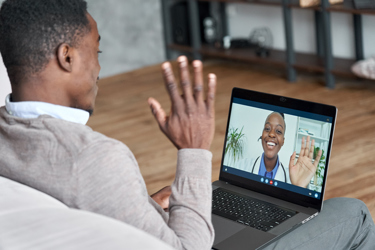The Evolution Of Telehealth: What's Next For Medical Device Companies?
By Teresa McArthur and Arnold Saperstein, Cecelia Health

Seemingly overnight, telehealth became 2020’s breakout star — coming in second behind the COVID-19 pandemic. Over the last five years, we have witnessed a marked shift in payer, provider, and patient perspectives regarding telehealth and, more specifically, telehealth-related medical devices. In this article, we share key insight into these perspectives and what they mean for medical device companies looking to penetrate the market successfully.
How COVID-19 Changed CMS Reimbursement
Before COVID-19, the Centers for Medicare and Medicaid Services (CMS) restricted telehealth to only Medicare beneficiaries who lived in rural locations. In 2018, this was only 7.8 million individuals compared to the roughly 36 million Medicare recipients that lived nationwide. Furthermore, telehealth had other limitations, including the following:
- Patients had to travel to an “originating site,” such as a hospital, physician’s clinic, or rural health clinic to receive a telehealth visit.
- Only a limited number of services could be provided through a telehealth visit.
- Patients could have a telehealth visit with a provider with whom they already had a pre-existing relationship.
- Technology utilized for the telehealth visit had to be HIPAA compliant.
- Only certain healthcare providers could bill for telehealth visits, and providers could not practice across state lines.
With such geographical and service restrictions, telehealth was used primarily as triage, such as for urgent care consultations to avoid emergency room visits. However, COVID-19 transformed telehealth into a means of providing actual care.
In a swift response to the pandemic, CMS made drastic changes to telehealth reimbursement. Several private payers have mirrored these changes, which include:
- Enabling patients to receive telehealth services anywhere, including their home
- Reimbursing providers the same amount for telehealth visits as in-person visits
- Allowing providers to see new and established patients via telehealth
- Making 80 more telehealth services available for reimbursement
- Loosening privacy regulations, allowing providers to have visits over mainstream videoconferencing platforms such as Zoom
- Permitting providers to practice across state lines
The results of this widespread expansion were unexpected. To illustrate, in late March 2020, CMS reported that telehealth visits had skyrocketed from around 10,000 visits per week to 300,000 visits per week.
Prior to the pandemic, evidence had shown that telehealth could improve the cost of care for chronic populations by 2 to 3%. As more payers, including CMS, tie quality and value to reimbursement, medical device companies have a great opportunity to position their devices as a cost-efficient way of improving patient outcomes.
How Physician Application Of Telehealth Has Evolved
Before the pandemic, the traditional clinic setting had its share of challenges, such as long waiting room times and patient no-shows. These barriers led to increased physician stress, cost inefficiency, and poor patient care management.
With much of telehealth’s red tape lifted, more physicians have realized its benefits. For example, physicians have told Cecelia Health that their virtual visits are happening in a timelier manner than their clinic visits.
In 2018 and then in 2021, CMS expanded remote physiologic monitoring (RPM) reimbursement, to encourage greater RPM adoption by physicians. However, some physicians remain apprehensive about prescribing RPM due to concerns regarding patient training and support as well as billing.
Patient Training And Support
While providers may have the option to prescribe a telehealth medical device through a virtual visit, they might not do so, despite the convenience. The reason often cited by PCPs we work with is that they lack the bandwidth to provide patients with the training and support necessary to be successful with a complex device like a continuous glucose monitor (CGM). Before prescribing a medical device, they want to know:
- Who will help the patient with device onboarding and uploading?
- Who can the patient turn to if they have questions about their device?
- Who will be there to make sure the patient is using the device to its full potential?
Physicians whose patients receive continuous device training and support express a greater willingness to incorporate RPM into their telehealth practice.
Billing
Many physicians and their clinic staff have expressed confusion regarding RPM reimbursement. This confusion often deters them from prescribing RPM as a care management tool. Or, if they do prescribe RPM, they may underutilize it due to misunderstandings regarding reimbursement.
For these reasons, it’s essential that medical device companies help clinicians understand the wide array of reimbursement codes associated with their devices. In doing so, they will gain physician trust, and in turn, new device users.
How Patients’ Experiences With RPM Devices Have Evolved
Before the pandemic, CMS heavily limited telehealth access according to several factors, including geography, service, and provider. Regardless of these restrictions, studies had revealed that, in general, patients were satisfied with telehealth. Now, one year after the pandemic began, more patients have realized telehealth’s value as they receive quality healthcare safely and conveniently.
While certain services will still need to be done in a brick-and-mortar setting — such as emergency care and certain physical exams — remote medical devices can be successfully implemented and used via telehealth. In our remote work with patients who use diabetic devices, we’ve not only seen virtual education and support lead to greater patient autonomy but also improved patient outcomes.
It’s important to note that the long-existing issues of understaffing in clinics, poorly trained medical personnel, and lack of follow-up from medical device companies remain unchanged from pre-pandemic. As a result, patients continue to express frustrations regarding implementing and using their new devices. Ultimately, they believe they have only two options: visit their provider’s clinic or stop using the device altogether.
Consumer demand for telehealth likely will continue to grow, thereby requiring medical device companies to meet this demand with adequate and consistent virtual training and support.
How Device Companies Have Changed Their Outlook On Telehealth
Before the pandemic, medical device companies were slow to embrace virtual-based training for new device launches. For example, some companies attempted video training but later stopped due to various reasons, including fears of liability and cost.
When the pandemic started, medical device companies had to shift their model from in-person to wherever the user was located — whether via a laptop, tablet, mobile phone, or desktop computer — and many medical device companies continue to use virtual visits to provide new device onboarding.
While more convenient for the patient, these virtual sessions still pose two problems:
- The training session often occurs only one time and is limited. One two-hour session is often not sufficient for the patient to retain all information and can result in frustration for both the patient and their PCP.
- It assumes the patient already knows enough about the device (through reading the manual or taking online tests, for example).
As a result of this sporadic, limited training, patients often leave their first training session with gaps of knowledge. This demotivates them to continue using their device.
Medical device companies have tried to address this issue by expanding their call centers by hiring more educators. However, we find that these efforts are often unsuccessful because of three reasons:
- Patients may have gone through other avenues for device assistance, such as social media and their clinician, before contacting a call center. Therefore, medical device companies should be careful to not overestimate their patients’ satisfaction based on call center results.
- Some patients lack the confidence or motivation to proactively reach out for help. As a result, they continue to struggle with their device, use it incorrectly, and never fully benefit from the features it has to offer. This can ultimately lead to patients abandoning the device altogether.
- While device companies can hire more educators to provide adequate onboarding, without proper follow-up, patients are unlikely to retain what they learned. Further, it may prove difficult to scale an education team at the same rate at which new devices are being released.
What’s In Store For Medical Device Companies?
Going forward, telehealth is expected to present further implications for medical device companies in terms of design and market penetration.
Medical devices are becoming more complex, often appealing to a younger, more tech-savvy audience. However, we have found that many users, including older adults, still use only roughly 25% of their device features. Consequently, they end up missing out on the more advanced features for fine-tuning their care. Medical device companies should, therefore, focus their device design on simplifying use for all patients, regardless of their comfort level with technology.
The bottom line is that telehealth is here to stay and will keep evolving. Therefore, it’s crucial that medical device companies take advantage of opportunities that are designed to deliver rewarding patient experiences.
About The Authors:
 Teresa McArthur is the senior vice president of Clinical Services at Cecelia Health. She is a Registered Dietitian and Certified Diabetes Care and Education Specialist with a master’s degree in clinical nutrition. Teresa has experience working with diabetes, health and wellness, nutrition support, weight, and chronic disease management. She has worked in various capacities, including higher education, long-term acute care, critical care, community nutrition, and inpatient and outpatient accredited diabetes management programs. She works with patients to identify specific barriers and set realistic and sustainable goals.
Teresa McArthur is the senior vice president of Clinical Services at Cecelia Health. She is a Registered Dietitian and Certified Diabetes Care and Education Specialist with a master’s degree in clinical nutrition. Teresa has experience working with diabetes, health and wellness, nutrition support, weight, and chronic disease management. She has worked in various capacities, including higher education, long-term acute care, critical care, community nutrition, and inpatient and outpatient accredited diabetes management programs. She works with patients to identify specific barriers and set realistic and sustainable goals.
 Arnold Saperstein is chief medical officer at Cecelia Health. He began his career in managed care in 1992 and joined MetroPlus Health Plan in 1995 initially as chief medical officer and then as president and CEO from 2006 until 2019. Saperstein has spent the majority of his career developing programs that ensure the highest quality of care. During his tenure at MetroPlus, it ranked as one of the highest scoring plans for quality of care as measured by the New York State Department of Health Medicaid Incentive Program and by the Medicaid Consumer Guide for New York City. Programs he developed included groundbreaking quality incentive pay for performance programs across the entire MetroPlus network.
Arnold Saperstein is chief medical officer at Cecelia Health. He began his career in managed care in 1992 and joined MetroPlus Health Plan in 1995 initially as chief medical officer and then as president and CEO from 2006 until 2019. Saperstein has spent the majority of his career developing programs that ensure the highest quality of care. During his tenure at MetroPlus, it ranked as one of the highest scoring plans for quality of care as measured by the New York State Department of Health Medicaid Incentive Program and by the Medicaid Consumer Guide for New York City. Programs he developed included groundbreaking quality incentive pay for performance programs across the entire MetroPlus network.
